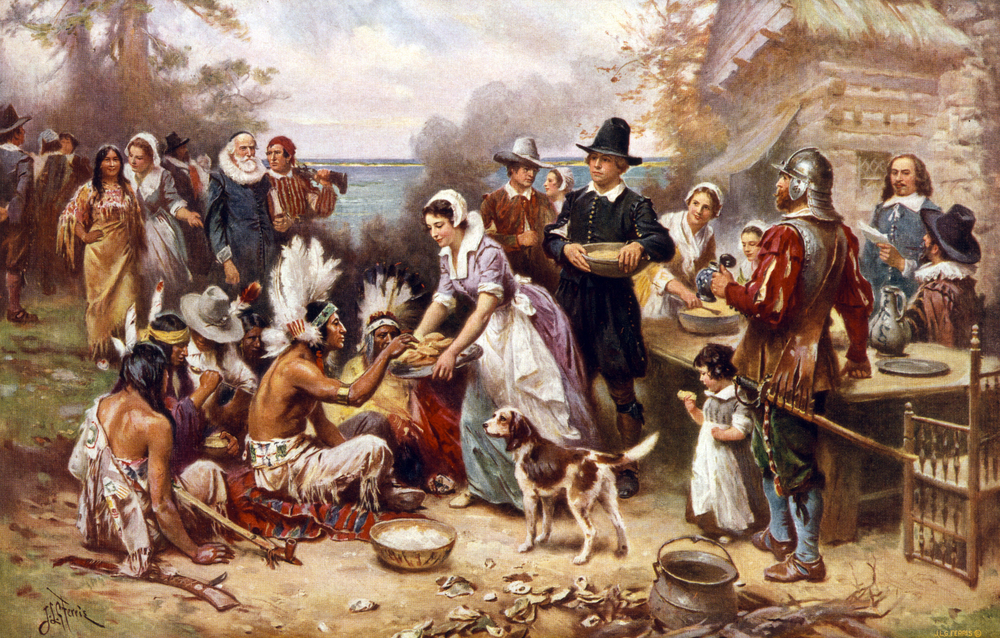
“Thus out of small beginnings greater things have been produced by His hand that made all things of nothing, and gives being to all things that are; and, as one small candle may light a thousand, so the light here kindled hath shone unto many…” (William Bradford, Of Plymouth Plantation)
The first Thanksgiving was a harvest celebration that the Pilgrims of Plymouth Colony held in the year 1621. We know very little about the event because we only have two firsthand accounts of the feast: William Bradford’s Of Plymouth Plantation and Edward Winslow’s Mourt’s Relations.
What we do know is that the Pilgrims held the first Thanksgiving feast to celebrate God’s goodness in a successful fall harvest. Celebrating a fall harvest was already an English tradition at the time. The Pilgrims knew that they had much to celebrate.
The fifty-three Pilgrims at the first Thanksgiving were the only colonists to survive the long journey on the Mayflower and the first winter in the New World. Disease and starvation had struck down half of the original 102 colonists. These Pilgrims made it through that first winter. By God’s grace and with the help of the local Wampanoag tribe, they had a hearty supply of food to sustain them through the next winter.
When Was the First Thanksgiving Celebrated?
Although the modern-day Thanksgiving feast takes place on the fourth Thursday of November, the first Thanksgiving did not. This feast most likely happened between September and November of 1621.
No one ever recorded the exact date of the feast, so we must assume it happened around the fall harvest. The celebration took place for three days and included recreational activities.
Who Attended the First Thanksgiving?
Guests at the feast included ninety Wampanoag natives from a nearby village, including their chief, Massasoit.
One of these natives, a brave named Squanto, spoke fluent English; Chief Massasoit appointed him to serve as the Pilgrim’s translator and guide. Squanto had learned English prior to the Pilgrim’s arrival after English explorers had captured him and taken him to Europe as a slave.
Neither Bradford’s nor Winslow’s accounts mention whether the natives were actually invited to the celebration. Many historians simply assume that the Pilgrims invited them. The natives had been so helpful to the Pilgrims during the first year. It certainly makes sense that the Pilgrims would have invited them. However, Edward Winslow’s account merely states:
“Our harvest being gotten in, our governor sent four men on fowling, that so we might after a special manner rejoice together, after we had gathered the fruits of our labors; they four in one day killed as much fowl, as with a little help beside, served the company almost a week, at which time amongst other recreations, we exercised our arms, many of the Indians coming amongst us, and amongst the rest their greatest king Massasoit, with some ninety men, whom for three days we entertained and feasted, and they went out and killed five deer, which they brought to the plantation and bestowed on our Governor, and upon the Captain and others. And although it be not always so plentiful, as it was at this time with us, yet by the goodness of God, we are so far from want, that we often wish you partakers of our plenty.”
Winslow, Edward. Mourt’s Relations
Sources:
“Primary Sources for the First Thanksgiving at Plymouth.” Pilgrim Hall Museum, www.pilgrimhall.org
Santino, Jack. All Around the Year: Holidays and Celebrations in American Life. University of Illinois Press, 1994.
Bradford, William and Winslow, Edward. Mourt’s Relations: Or the Journal of the Plantation at Plymouth. John Bellamy, 1622.
